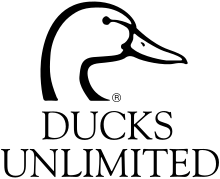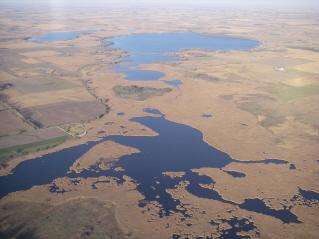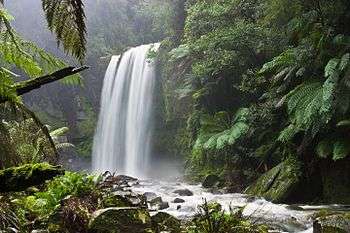Ducks Unlimited
Ducks Unlimited (DU) is an American nonprofit organization 501(c) dedicated to the conservation of wetlands and associated upland habitats for waterfowl, other wildlife, and people. It has had a membership of around 700,000 since January 2013.[2]
 | |
| Founded | 1937 |
|---|---|
| Founder | Joseph Knapp |
| Type | Habitat Conservation and Hunting |
| Focus | waterfowl habitat conservation |
| Location | |
Area served | North America |
Members | 700,000 |
Key people | Rogers Hoyt Jr., President Adam Putnam, CEO[1] |
Volunteers | 40,000 |
| Website | www.ducks.org |
History and profile
In 1927, an offshoot of the Boone and Crockett Club was created specifically for sport bird management and operated until 1930 as the American Wild Fowlers. Membership included such people as Arthur Bartley and Nash Buckingham, who would later be involved in the conservation movement. In 1930, Joseph P. Knapp, a publishing tycoon who successfully obtained such notable publications as The Associated Sunday Magazine, Crowell Publishing Company, Collier’s Weekly, Farm and Fireside, and the book publisher P.F. Collier & Sons, founded More Game Birds in America and American Wild Fowlers was quickly absorbed into the new organization.
In 1937, Knapp, Robert Winthrop, and a small group of conservation philanthropists decided to focus on the decreasing waterfowl populations, and the habitat necessary to sustain them in Canada. Ducks Unlimited was incorporated on January 29, 1937.[3] More Game Birds in America was then absorbed by the new waterfowl organization.[4][5][6] Ducks Unlimited Canada was incorporated in Winnipeg, Manitoba, on March 10, 1937.[7]
Ducks Unlimited also works in Mexico through their sister organization, Ducks Unlimited de Mexico. Other chapters have since begun operation in Latin America, Mexico, New Zealand, and Australia.[8]
Ducks Unlimited has conserved at least 12.5 million acres[9] of waterfowl habitat in North America.[10] DU partners with a wide range of corporations, governments, other non-governmental organizations, landowners, and private citizens to restore and manage areas that have been degraded and to prevent further degradation of existing wetlands. DU is also active in working with others to recommend government policies that will influence wetlands and the environment.[11] DU generated more than $235 million in revenues during their 2012 fiscal year,[10] a minimum of 80 percent[9] of that revenue goes directly toward habitat conservation.[2] Their sources of revenue include federal and state habitat reimbursements, conservation easements, sponsors, members, major gifts, donations, royalties and advertisement.
The majority of DU's financial contributors and 90 percent of members are hunters.[9] Its DU Magazine contains many historical and practical articles on waterfowl hunting, and it obtains revenue from advertisements of waterfowling equipment such as shotguns, ammunition, decoys, and bird calls. Additional revenue is raised by commissioning artists to create duck artwork, with a portion going to the artist and the majority share of revenue going to Ducks Unlimited. Eric Thorsen is one wildlife artists who have contributed their artwork for the purpose of fundraising.[12] In 2019, Ducks Unlimited Canada and the University of Saskatchewan partnered to establish the "Ducks Unlimited Canada Endowed Chair in Wetland and Waterfowl Conservation". The position will aid the university faculty and students with environmental education, research, and outreach.[13]
2017 Annual Report
According to Ducks Unlimited 2017 Annual Report, 2017 marked the seventh consecutive year that the budget goals were surpassed, with total revenues approaching $224 million. Over 58,000 Ducks Unlimited volunteers organized 4,050 events which attracted over 577,000 attendees. The $86 million of philanthropic revenue generated in 2017 surpassed that which was raised in 2016 by over $1.8 million from contributions by 5,000 donors and 700,000 members.
Conservation
Traditionally, most Ducks Unlimited wetland conservation projects were conducted on waterfowl breeding areas in the Canadian prairies by its sister organization, Ducks Unlimited Canada (DUC). DUC has since expanded its operations to include projects in every Canadian province and territory, not just in the prairies. Ducks Unlimited has also expanded its operations to include conservation projects in every state of the United States and in Mexico. It retains primary focus on habitats most important to waterfowl; including the restoration of duck breeding habitats in Canada and the northern central states, and duck overwintering habitat, mostly in the coastal and southern states and in Mexico.
Methods
Some of the methods used by Ducks Unlimited to conserve habitats are:[14]
- Restoring grassland
- Grassland cover helps hens conceal their nests and increases their chances of successfully hatching a clutch. This then increases sexual productivity and heightens the chance of producing offspring.
- Replanting forests
- Forests that flood regularly due to overflowing riverbanks, such as the bottomland hardwood forests in the Mississippi Alluvial Valley, make for ideal wintering habitat for ducks, and provide essential breeding and foraging habitat for other wildlife species. 80% of these forests have been cleared and natural flooding has been reduced by 50–90%.
- Restoring watersheds
- When watersheds are disturbed, contaminants wash into wetlands which then disrupts the plants, fish, and animals. DU restores drained wetlands, protects stream corridors and establishes buffer strips that filter nutrients and silt.
- Educating landowners
- DU works with farmers, ranchers and other landowners to improve the agricultural and recreational value of their land while making it more wildlife-friendly.
- Conservation easements
- Conservation easements protect the natural resource values of a property in perpetuity. The landowner maintains actual ownership of the land, but agrees to certain development restrictions. Since 75% of U.S. wetlands are on private property, conservation easements play a crucial role in the conservation movement.
- Acquiring land
- The direct purchase of wetlands to restore and protect it. Once restoration is complete, DU generally sells or donates the property to a group or agency that will manage it for wildlife.
Ducks Unlimited also works closely with government leaders, conservation leaders, private landowners, and farmers to ensure that environmental provisions are contained in the Farm Bill. The Farm Bill supports programs such as the Conservation Reserve Program (CRP) and Wetlands Reserve Program (WRP).
Coastal cleanup
Following the 2010 Deepwater Horizon oil spill in the Gulf of Mexico, Ducks Unlimited became involved with multiple clean-up efforts in Gulf states. The organization worked with the National Fish and Wildlife Foundation and the USDA Natural Resources Conservation Service to protect approximately 79,000 acres of waterfowl and other water bird habitat.[15] In 2015, Ducks Unlimited partnered with The Trust for Public Land to build an online database that tracked conservation and cleanup efforts following the Deepwater Horizon spill.[16] On August 16, 2018, the National Oceanic and Atmospheric Administration (NOAA) announced a $1.8 million cooperative agreement with Ducks Unlimited to clean up oil spills and hazardous waste releases in the Gulf of Mexico in the state of Texas.[17]
Regions of special interest

Ducks Unlimited takes a continental, landscape approach to wetland conservation. While DU works in all 50 states, the organization focuses its efforts and resources on the habitats most beneficial to waterfowl and in greatest jeopardy of disappearing. The following areas are considered to be DU's top 5 conservation priorities:[2]
- Prairie Pothole Region[18]
- Western Boreal Forest of Canada [19]
- Mississippi Alluvial Valley[20]
- Central Valley and Coastal California[21]
- Gulf Coastal Prairie[22]
Ducks Unlimited TV
Ducks Unlimited produces a television show, Ducks Unlimited TV a.k.a. DUTV. This show is hosted by Field Hudnall, Wade Bourne and Ainsley Beeman. The show highlights conservation and waterfowl hunting across the United States.[23]
See also
References
- "DU National Staff & Board of Directors". Ducks Unlimited. Retrieved 2013-01-15.
-
"National Fact Sheet" (PDF). Ducks Unlimited.
"National Fact Sheet" (PDF). Ducks Unlimited. March 2013. Archived from the original (PDF) on March 28, 2013. Retrieved January 6, 2017.
"National Fact Sheet" (PDF). Ducks Unlimited. February 2015. Archived from the original (PDF) on February 22, 2016. Retrieved January 6, 2017.
"National Fact Sheet" (PDF). Ducks Unlimited. February 2017. Archived from the original (PDF) on June 6, 2017. Retrieved April 14, 2019.
"National Fact Sheet" (PDF). Ducks Unlimited. February 2019. Archived from the original (PDF) on March 31, 2019. Retrieved April 14, 2019. - Ken Babcock. "Milestones in Conservation". Ducks Unlimited. Retrieved 2019-04-14.
- "Ducks Unlimited Honored by B&C Club". boone-crockett.org. Boone and Crockett Club. March 21, 2012. Retrieved January 5, 2017.
- Bolen, Eric (April 2000). "Waterfowl Management: Yesterday and Tomorrow". The Journal of Wildlife Management. 64 (2): 323–335. doi:10.2307/3803230. JSTOR 3803230.
- The Wild Fowlers of North America (1927). "A Proposed Plan of Activities for The Wild Fowlers of North America". Boone and Crockett Club Records. Archived from the original on 2014-03-07. Retrieved January 5, 2017 – via Montana Memory Project.
- "Ducks Unlimited". Ducks. 76 (1): 10. January–February 2012.
- "Ducks Unlimited's International Programs". Ducks Unlimited. Archived from the original on 2007-04-28. Retrieved 2007-06-25.
- "Ducks Unlimited and Hunting". Ducks Unlimited. Retrieved January 5, 2017.
- Jones, Lindsay (Fall 2012). "Ducks in a Row". Philanthropy. Retrieved 8 January 2013.
- "Public Policy". Ducks Unlimited. Retrieved January 5, 2017.
- Bjork, Kay (25 March 1992). "Pair Carves Niche With Business". Bigfork Eagle. p. 11.
- "Ducks Unlimited Canada and USask partner to advance wetland and waterfowl conservation in Canada". News. Retrieved 2020-05-19.
- "How DU Conserves Wetlands and Waterfowl". Ducks Unlimited. Retrieved 8 January 2013.
- Schleifstein, Mark (April 19, 2013). "BP Deepwater Horizon oil spill draws wide array of comments on 3rd anniversary". NOLA.com. Retrieved December 13, 2018.
- Schleifstein, Mark (April 24, 2015). "Keep track of BP oil spill restoration projects with new web database". NOLA.com. Retrieved December 13, 2018.
- "NOAA Announces Latest Partnership to Restore Habitats Damaged by Oil and Hazardous Waste". DARRP | NOAA. August 16, 2018. Retrieved December 13, 2018.
- "Prairie Pothole Region". Ducks Unlimited. Retrieved 2013-01-15.
- "Western Boreal Forest - Canada". Ducks Unlimited. Retrieved 2013-01-15.
- "Mississippi Alluvial Valley". Ducks Unlimited. Retrieved 2013-01-15.
- "Central Valley / Coastal California". Ducks Unlimited. Retrieved 2013-01-15.
- "Gulf Coastal Prairie". Ducks Unlimited. Retrieved 2013-01-15.
- "Watch the best outdoor shows for free on CarbonTV". CarbonTV. Retrieved 2016-02-08.
